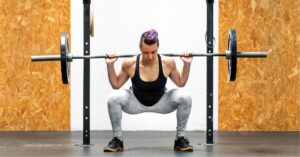Hey there, fitness enthusiasts and curious minds! If you’ve ever wondered about the magical moment when you can confidently say, ‘I’m strong in squatting,’ you’re in the right place.
Squatting is a fundamental exercise that serves as a litmus test for lower body strength.
In this blog post, we’ll explore the different checkpoints along the strength journey and help you identify at what point you can truly consider yourself ‘strong’ in squatting.
Whether you’re a beginner or a seasoned lifter aiming for new heights, let’s dive into the world of squat strength together!
Understanding the point have you become strong in squatting.
While the point at which you can consider yourself “strong” in squatting can vary depending on your individual goals, body type, and training background, here are some general benchmarks that you can use to gauge your strength in squatting:
Bodyweight Squat: Being able to perform a squat with good form using only your bodyweight is often considered a basic level of strength.
This means squatting down until your thighs are parallel to the ground or lower.
1.5x Bodyweight Squat: Many strength enthusiasts aim to squat a weight that is 1.5 times their body weight. This is often seen as an intermediate level of strength.
2x Bodyweight Squat: Squatting twice your body weight is often considered a significant milestone and is seen as a sign of advanced strength.
3x Bodyweight Squat or More: Squatting three times your body weight or more is typically reserved for elite powerlifters and highly dedicated strength athletes.

It’s important to note that strength is relative, and what is considered strong for one person may not be the same for another.
Your age, gender, and training experience can all influence what is considered strong for you personally. Additionally, having proper squatting form and avoiding injury should always be a priority, regardless of the weight you’re lifting.
Ultimately, becoming strong in squatting is a gradual process that requires consistent training, dedication, and a focus on progressive overload, where you gradually increase the weight you lift over time. It’s important to set realistic goals and track your progress as you work towards becoming stronger in the squat.
Further Explanations.
Let’s dive deeper and elaborate further on all the points mentioned.
Firstly though, let’s delve deeper into the different levels of strength in squatting:
Bodyweight Squat:
This is the foundational level of squat strength.
It means you can perform a squat using only your body weight as resistance, without the need for additional weights.
Good form is crucial here. You should be able to squat down until your thighs are parallel to the ground or lower. This means your hips should descend roughly to the level of your knees.
The bodyweight squat is often one of the first exercises people learn when they start strength training. It’s important for developing mobility, balance, and a basic level of lower body strength.

Squat
1.5x Bodyweight Squat:
This represents an intermediate level of squat strength.
To achieve this, you should aim to squat with a weight that is 1.5 times your own body weight.
For example, if you weigh 150 pounds (68 kg), you’d aim to squat around 225 pounds (102 kg).
This level of strength demonstrates that you have progressed beyond just using your body weight for resistance and can handle a significant load.
Achieving a 1.5x bodyweight squat requires consistent training and progressive overload, where you gradually increase the weight you lift over time.
It typically indicates a good foundation of lower body strength and a commitment to strength training.
It’s essential to remember that these strength levels are not set in stone and can vary from person to person.
What’s most important is that you’re continually challenging yourself, improving your form, and working towards your own personal goals.
Additionally, always prioritize safety and proper form to avoid injury as you progress in your squatting strength journey.
let’s explore the higher levels of strength in squatting:
2x Bodyweight Squat:
Achieving a 2x bodyweight squat is a significant milestone and represents an advanced level of strength.
To reach this level, you should be able to squat with a weight that is double your own body weight.
For example, if you weigh 150 pounds (68 kg), you’d aim to squat around 300 pounds (136 kg).
This level of strength is often considered impressive in the fitness and strength training community.
It typically requires years of dedicated training, solid technique, and consistent progression in terms of the weights you lift.
Many powerlifters and serious strength enthusiasts aim for this milestone as they continue to push their limits.
3x Bodyweight Squat or More:
Squatting three times your body weight or more is an exceptional level of strength that is typically reserved for elite powerlifters and highly dedicated strength athletes.
For instance, if you weigh 150 pounds (68 kg), squatting 450 pounds (204 kg) or more would fall into this category.
Achieving this level of strength represents not only an incredible amount of lower body strength but also an immense dedication to training, nutrition, and recovery.
Elite powerlifters who compete at the highest levels often aim for or exceed this level of squat strength, as it’s essential for their performance in competitions.
It’s important to note that very few individuals reach this level, and it requires years of specialized training and often a professional coaching and support system.
In summary, the 2x bodyweight squat is considered a significant achievement and represents advanced strength, while the 3x bodyweight squat or more is a rare feat typically attained by elite powerlifters and those who dedicate their lives to strength training.
These levels of strength serve as inspirational milestones for those on their strength training journey, but they should always be pursued with an emphasis on safety, proper technique, and gradual progression.
A complete tabular on this topic here.
Here’s a complete tabular breakdown of different levels of strength in squatting:
| Strength Level | Description | Example (for a 150-pound individual) |
|---|---|---|
| Bodyweight Squat | Basic level of strength, squatting with your body weight. | Squatting with good form using only your body weight. |
| 1.5x Bodyweight Squat | Intermediate level of strength, 1.5 times your body weight. | Squatting around 225 pounds (102 kg) for a 150-pound (68 kg) individual. |
| 2x Bodyweight Squat | Advanced strength milestone, squatting twice your body weight. | Squatting around 300 pounds (136 kg) for a 150-pound (68 kg) individual. |
| 3x Bodyweight Squat or More | Exceptional strength level, typically for elite athletes. | Squatting 450 pounds (204 kg) or more for a 150-pound (68 kg) individual. |
Please note that these are general guidelines and that the definition of “strong” can vary based on individual goals and circumstances.
The examples provided are based on a 150-pound individual for reference, and actual weightlifting goals may differ based on one’s body weight and training objectives.
Conclusion.
You can consider yourself “strong” in squatting when you achieve a 2x bodyweight squat or higher.
This represents advanced strength, while the 1.5x bodyweight squat is an intermediate milestone, and the bodyweight squat is a basic level of strength.

Hey there, it’s Mike Rrsq, the Editor-in-Chief over at Jsquat.com, and I’m absolutely obsessed with all things squat fitness! I’ve been lucky enough to get some serious recognition for my work in this field. With a solid background in the fitness and wellness industry, I’ve been there right from the get-go, helping shape this website into what it is today.
You see, I’m not just the boss around here; I’m also a passionate contributor. I love sharing my insights through my articles, and trust me, they’re not your run-of-the-mill stuff. Each piece I write is a labor of love, filled with my expertise and real-world experience in the fitness universe. So, if you’re into fitness and looking for some inspiration, you’re in the right place!

